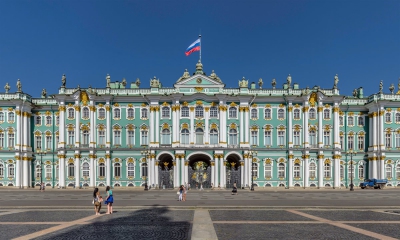The February Revolution (Russian: , tr. Fevral'skaya revolyutsiya, IPA: [fvralskj rvlutsj]), known in Soviet historiography as the February Bourgeois Democratic Revolution and sometimes as the March Revolution, was the first of two revolutions which took place in Russia in 1917.
The main events of the revolution took place in and near Petrograd (present-day Saint Petersburg), the then-capital of Russia, where long-standing discontent with the monarchy erupted into mass protests against food rationing on 23 February Old Style (8 March New Style). Revolutionary activity lasted about eight days, involving mass demonstrations and violent armed clashes with police and gendarmes, the last loyal forces of the Russian monarchy. On 27 February O.S. (12 March N.S.) the garrison forces of the capital sided with the revolutionaries. Three days later Tsar Nicholas II abdicated, ending Romanov dynastic rule and the Russian Empire. A Russian Provisional Government under Prince Georgy Lvov replaced the Council of Ministers of Russia.
The Provisional Government would prove deeply unpopular and was forced to share dual power with the Petrograd Soviet. After the July Days, in which the Government killed hundreds of protesters, Alexander Kerensky became head of Government. He was unable to fix Russia's immediate problems, including food shortages and mass unemployment, as he attempted to keep Russia involved in the ever more unpopular war. The failures of the Provisional Government led to the October Revolution by the Communist Bolsheviks later that year. The February Revolution had weakened the country; the October Revolution broke it, resulting in the Russian Civil War and the eventual formation of the Soviet Union.
The revolution appeared to have broken out without any real leadership or formal planning. Russia had been suffering from a number of economic and social problems, which compounded after the start of World War I in 1914. Disaffected soldiers from the city's garrison joined bread rioters, primarily women in bread lines, and industrial strikers on the streets. As more and more troops of the undisciplined garrison of the Capital deserted, and with loyal troops away at the Front, the city fell into chaos, leading to the Tsar's decision to abdicate under his generals' advice. In all, over 1,300 people were killed during the protests of February 1917. The historiographical reasons for the revolution have varied. Russian historians writing during the time of the Soviet Union cited the cause as the anger of the proletariat against the bourgeois boiling over. The Russian Liberals cited World War I. Revisionists track it back to land disputes after the Serf era. Modern historians cite a combination of these factors and criticize the mythologization of the event.
Saint Petersburg (Russian: Санкт-Петербург, tr. Sankt-Peterburg, IPA: [ˈsankt pʲɪtʲɪrˈburk] (listen)), formerly known as Petrograd (1914–1924) and later Leningrad (1924–1991), is the second-largest city in Russia. It is situated on the Neva River, at the head of the Gulf of Finland on the Baltic Sea, with a population of roughly 5.4 million residents. Saint Petersburg is the fourth-most populous city in Europe, the most populous city on the Baltic Sea, as well as the world's northernmost city with over 1 million residents. As Russia's Imperial capital, and a historically strategic port, it is governed as a federal city.
The city was founded by Tsar Peter the Great on 27 May 1703 on the site of a captured Swedish fortress, and was named after apostle Saint Peter. Saint Petersburg is historically and culturally associated with the birth of the Russian Empire and Russia's entry into modern history as a European great power. It served as a capital of the Tsardom of Russia, and the subsequent Russian Empire, from 1713 to 1918 (being replaced by Moscow for a short period of time between 1728 and 1730). After the October Revolution in 1917, the Bolsheviks moved their government to Moscow.Saint Petersburg is known as the "Cultural Capital of Russia," and received over 15 million tourists in 2018. It is considered an important economic, scientific, cultural, and tourism centre of Russia and Europe. In modern times, the city has the nickname of the "Northern Capital" and serves as a home to some federal government bodies such as the Constitutional Court of Russia and the Heraldic Council of the President of the Russian Federation. It is also a seat for the National Library of Russia and a planned location for the Supreme Court of Russia, as well as the home to the headquarters of the Russian Navy, and the Western Military District of the Russian Armed Forces. The Historic Centre of Saint Petersburg and Related Groups of Monuments constitute a UNESCO World Heritage Site. Saint Petersburg is home to the Hermitage, one of the largest art museums in the world, the Lakhta Center, the tallest skyscraper in Europe, and was one of the host cities of the 2018 FIFA World Cup and the UEFA Euro 2020.

1917Feb, 23
First demonstrations in Saint Petersburg, Russia. The beginning of the February Revolution (March 8 in the Gregorian calendar).
Choose Another Date
Events on 1917
- 22Jan
Woodrow Wilson
World War I: President Woodrow Wilson of the still-neutral United States calls for "peace without victory" in Europe. - 15Mar
Nicholas II of Russia
Tsar Nicholas II of Russia abdicates the Russian throne ending the 304-year Romanov dynasty. - 2Apr
Woodrow Wilson
World War I: United States President Woodrow Wilson asks the U.S. Congress for a declaration of war on Germany. - 5Jun
Conscription
World War I: Conscription begins in the United States as "Army registration day". - 27Jul
Battle of Passchendaele
The Allies reach the Yser Canal at the Battle of Passchendaele.

 English
English  español
español  français
français  português
português  русский
русский  العربية
العربية  简体中文
简体中文 